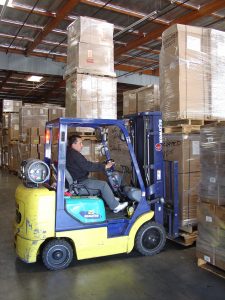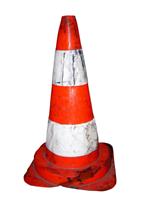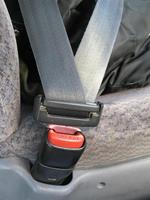 While attending college, I worked at various manufacturing companies where I, like those around me, worked in tandem with forklift trucks. Those of us working on the floor were aware of the forklifts but didn’t truly understand the potential hazards. We would go about the day’s work with the forklifts buzzing around us, horns beeping and engines roaring. After all, that was the norm….another eight-to-ten hour shift where you just wanted to get the work done and go home. There would be the occasional near-miss of a coworker, or someone coming close to a moving forklift, but no one would get hurt and you’d just smile and keep working. Through idle talk with veteran coworkers, I’d hear about “so-and-so” or “…who doesn’t work here anymore” getting hurt while goofing around or irresponsibly operating around a forklift. After the conversation, I’d go back to work not fully comprehending what was just said. I never really thought about just how heavy and powerful these vehicles were. Forklifts are smaller than cars, but lift tons of material to overhead heights. They’re compact, in some cases rather quiet, and move around unnoticed. All of this adds up to how forklifts can easily blend into the background of the everyday worker.
While attending college, I worked at various manufacturing companies where I, like those around me, worked in tandem with forklift trucks. Those of us working on the floor were aware of the forklifts but didn’t truly understand the potential hazards. We would go about the day’s work with the forklifts buzzing around us, horns beeping and engines roaring. After all, that was the norm….another eight-to-ten hour shift where you just wanted to get the work done and go home. There would be the occasional near-miss of a coworker, or someone coming close to a moving forklift, but no one would get hurt and you’d just smile and keep working. Through idle talk with veteran coworkers, I’d hear about “so-and-so” or “…who doesn’t work here anymore” getting hurt while goofing around or irresponsibly operating around a forklift. After the conversation, I’d go back to work not fully comprehending what was just said. I never really thought about just how heavy and powerful these vehicles were. Forklifts are smaller than cars, but lift tons of material to overhead heights. They’re compact, in some cases rather quiet, and move around unnoticed. All of this adds up to how forklifts can easily blend into the background of the everyday worker.
Fast forward to today. I am a geologist, an industrial hygienist, and working towards becoming a Certified Safety Professional. I am older and (somewhat) wiser now, but it wasn’t until recently that I became a safety forklift trainer. Now I understand just how lucky I was during my younger professional life. This year alone, approximately 95,000 people will be injured. Worse yet is that almost 100 people will be killed while working with or around these vehicles. Most of these accidents could have been prevented by improving worker awareness, providing proper training, and implementing various engineering controls and administration procedures.
Hazard Awareness
 However, my safety training started the moment I realized just how powerful and heavy these compact vehicles are. This first step is called “awareness” and it starts with proper communication and understanding. The average weight of a forklift is between 7,500 and 10,000 pounds. Honestly, they do not look like they weigh this amount, but they do! I have seen YouTube videos of people jumping on the rear of a forklift to help counter balance a lifted load that’s tipping over. Now you have to ask yourself “does my 180 pounds of weight really make a difference when the opposing weight being lifted is 7,000 pounds?” The short answer is “NO”, but more often than not, I see new videos much like this being uploaded onto the internet.
However, my safety training started the moment I realized just how powerful and heavy these compact vehicles are. This first step is called “awareness” and it starts with proper communication and understanding. The average weight of a forklift is between 7,500 and 10,000 pounds. Honestly, they do not look like they weigh this amount, but they do! I have seen YouTube videos of people jumping on the rear of a forklift to help counter balance a lifted load that’s tipping over. Now you have to ask yourself “does my 180 pounds of weight really make a difference when the opposing weight being lifted is 7,000 pounds?” The short answer is “NO”, but more often than not, I see new videos much like this being uploaded onto the internet.
Forklift Training
Closely following the awareness step is training. Everyone loves sitting for long hours in a dimly lit conference room while a stranger instructs them repeatedly on the dangers of something you’ve used for years. Foremost, effective training starts with a positive attitude to learning. You must understand that the reason you are undergoing forklift safety training is because there are those us who have operated forklifts are no longer with us. Since 1999, any person(s) operating a forklift must be trained and certified, and here is the “inside” knowledge of the forklift training. Forklift training is based on repetition. The repetition of facts, statistics, safety, and operational procedures which must be understood so that you, as a forklift operator, can determine what is right, wrong, or irresponsible. The Occupational Safety and Health Administration (OSHA) set forth the Powered Industrial Trucks standard (29 CFR 1910.178) standard in 1999 to outline the training operators must receive.
Engineering and Administration Controls
 Complementing awareness and training are engineering controls. Examples of effective engineering controls may include the modification of forklifts to include a sensor system that prevents the vehicle from starting unless a seat belt is buckled. Other engineering controls include proper warning signs on the forklifts and in walking areas.
Complementing awareness and training are engineering controls. Examples of effective engineering controls may include the modification of forklifts to include a sensor system that prevents the vehicle from starting unless a seat belt is buckled. Other engineering controls include proper warning signs on the forklifts and in walking areas.
I mentioned at the beginning of this blog “like those around me, working in tandem with forklifts”, meaning it is not only the forklift operator, but those around the vehicle who must be aware and kept safe. Simply put, engineering controls in working environments are an effective way of preventing injuries (and even deaths) at the workplace. To be effective, these controls must be reinforced with effective training. No matter what the engineering control, it should be in good working order, legible if written, and understood by everyone working at the company.
Administration procedures tie awareness, training, and engineering controls together. Your boss or supervisor should understand the OSHA Powered Industrial Trucks standard and know that all employees who operate a forklift or other powered industrial trucks must be properly trained and certified. Your company should have standard operating procedures (SOPs) which align with the owner manual and operating instructions for each type of powered industrial truck. Of course, each owner’s manual must remain with the industrial truck for quick and easy review.
In Summary…
As I started with, I used work in the manufacturing industry and never fully comprehended just how dangerous it was to work around forklifts until recently. While vital to everyday operations, the operation of these industrial vehicles comes with a great deal of responsibility to keep the operator (and those around him) safe.
by Kris Bills
Kris Bills is a certified trainer for forklifts, telehandlers, and aerial platform vehicles. For more information on forklift and powered industrial truck safety training classes CLICK HERE.

